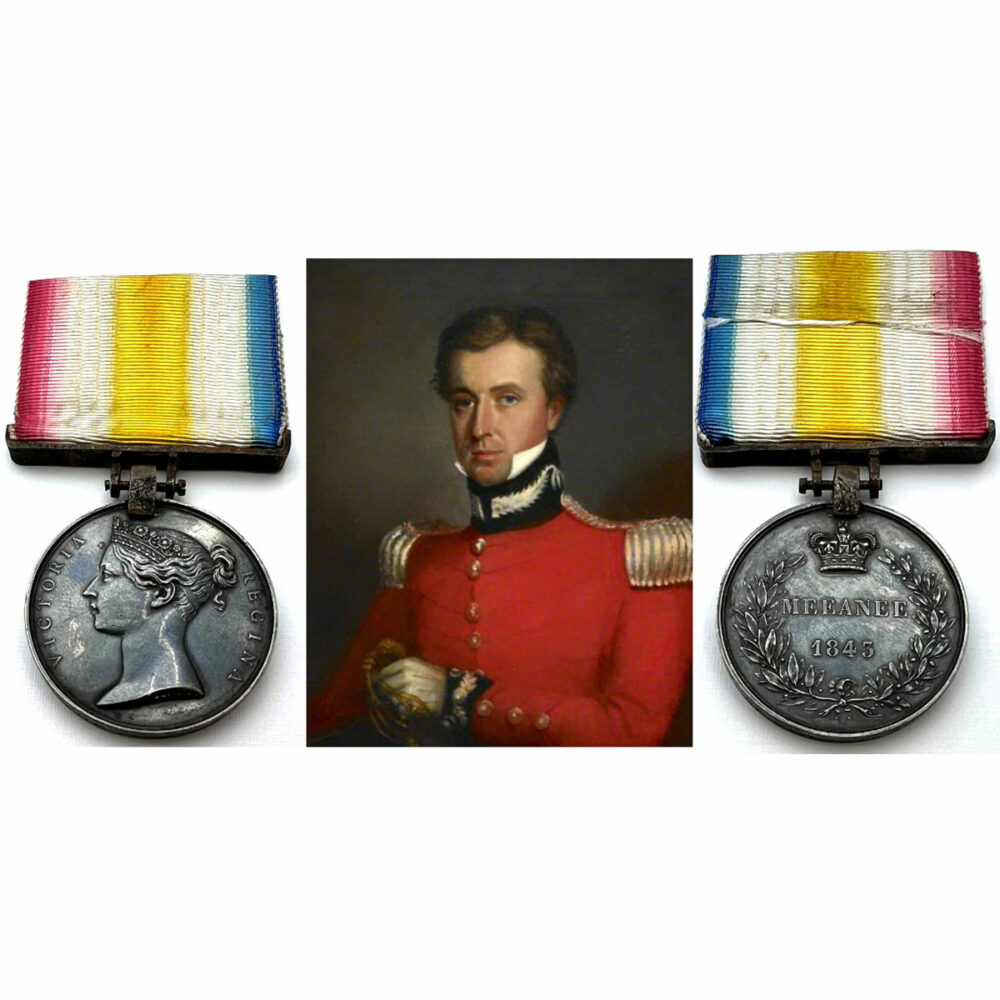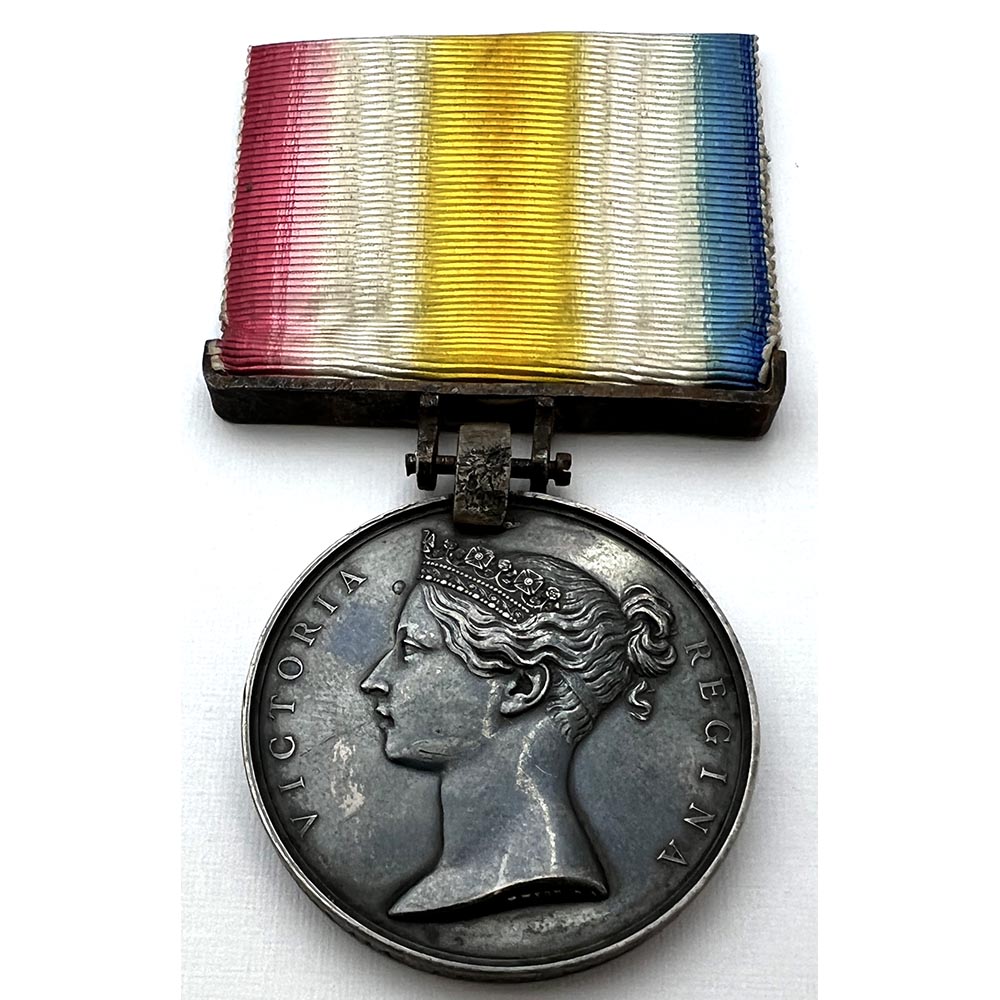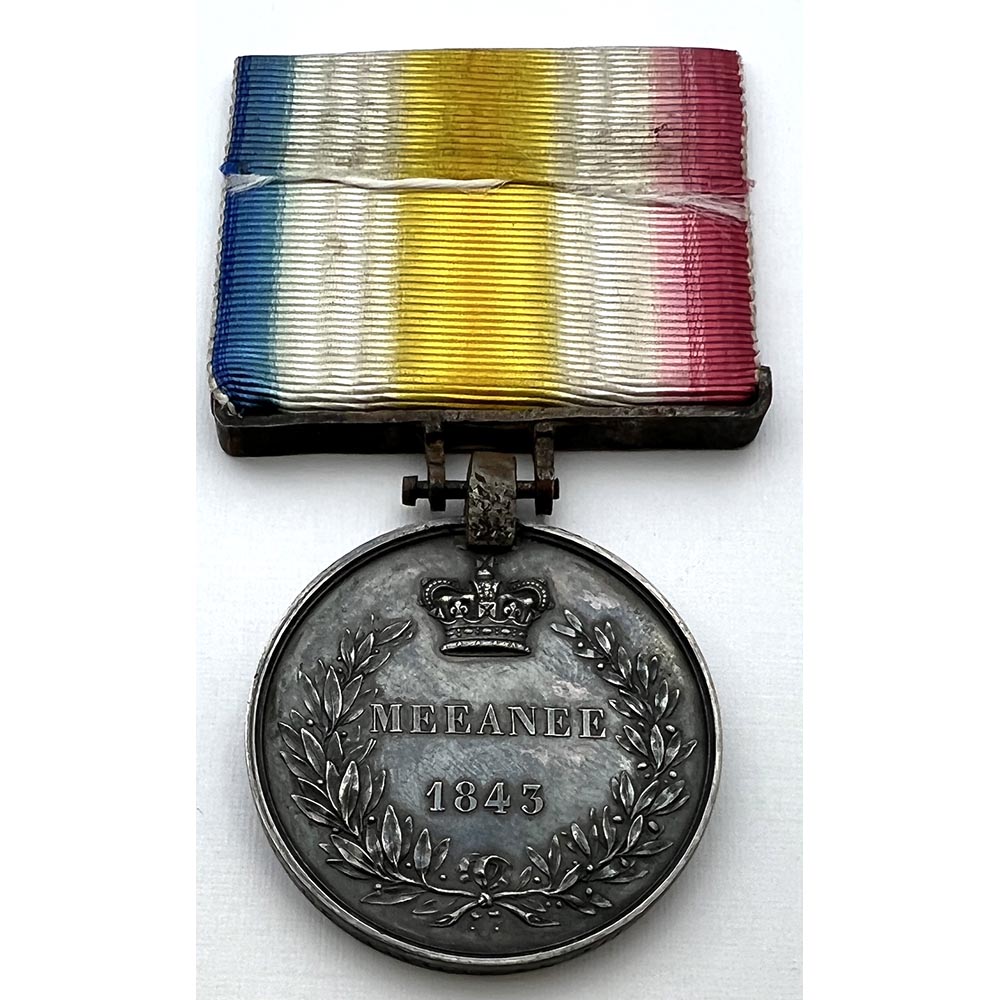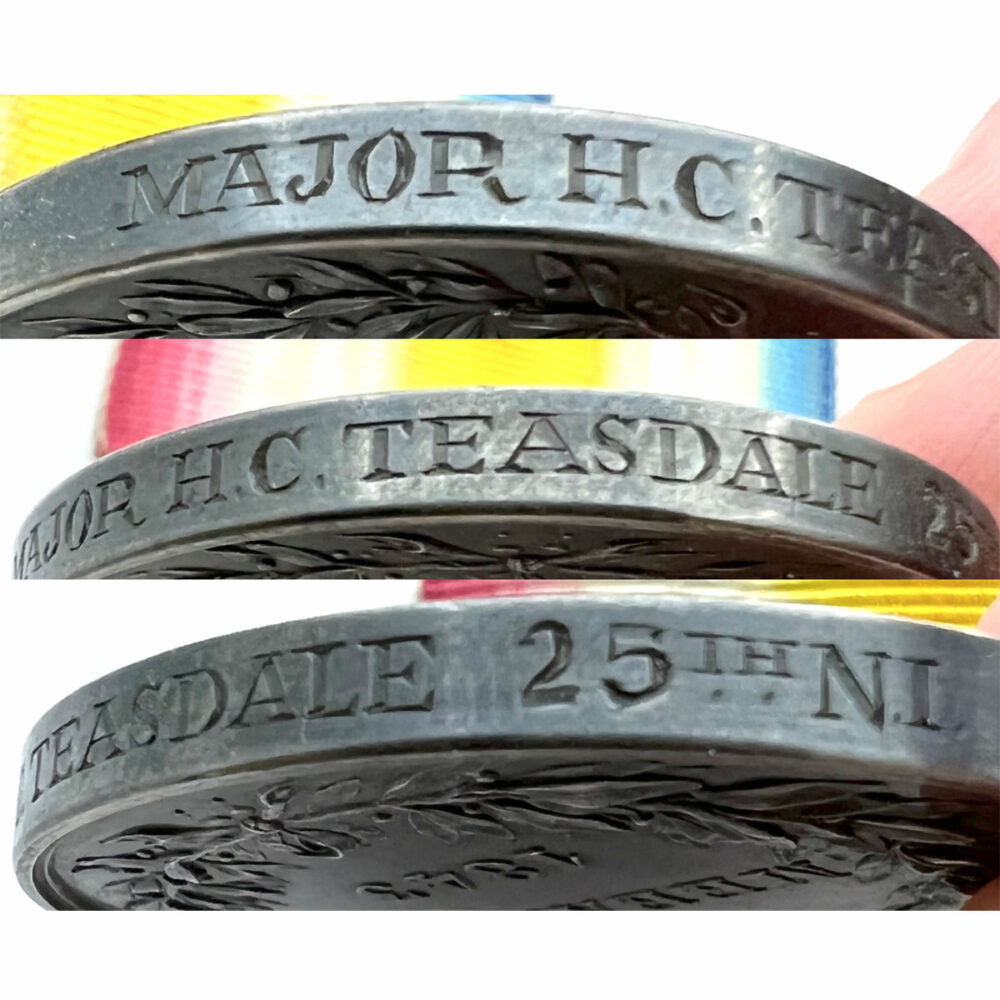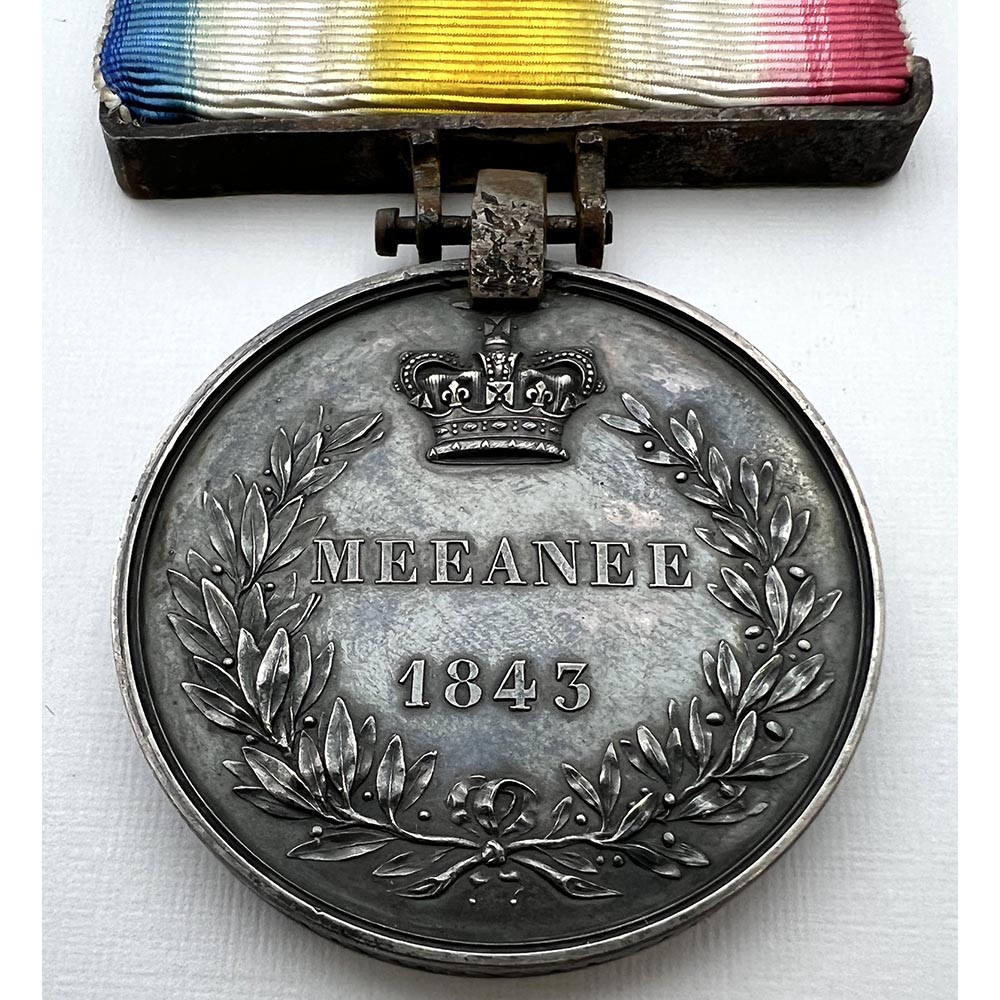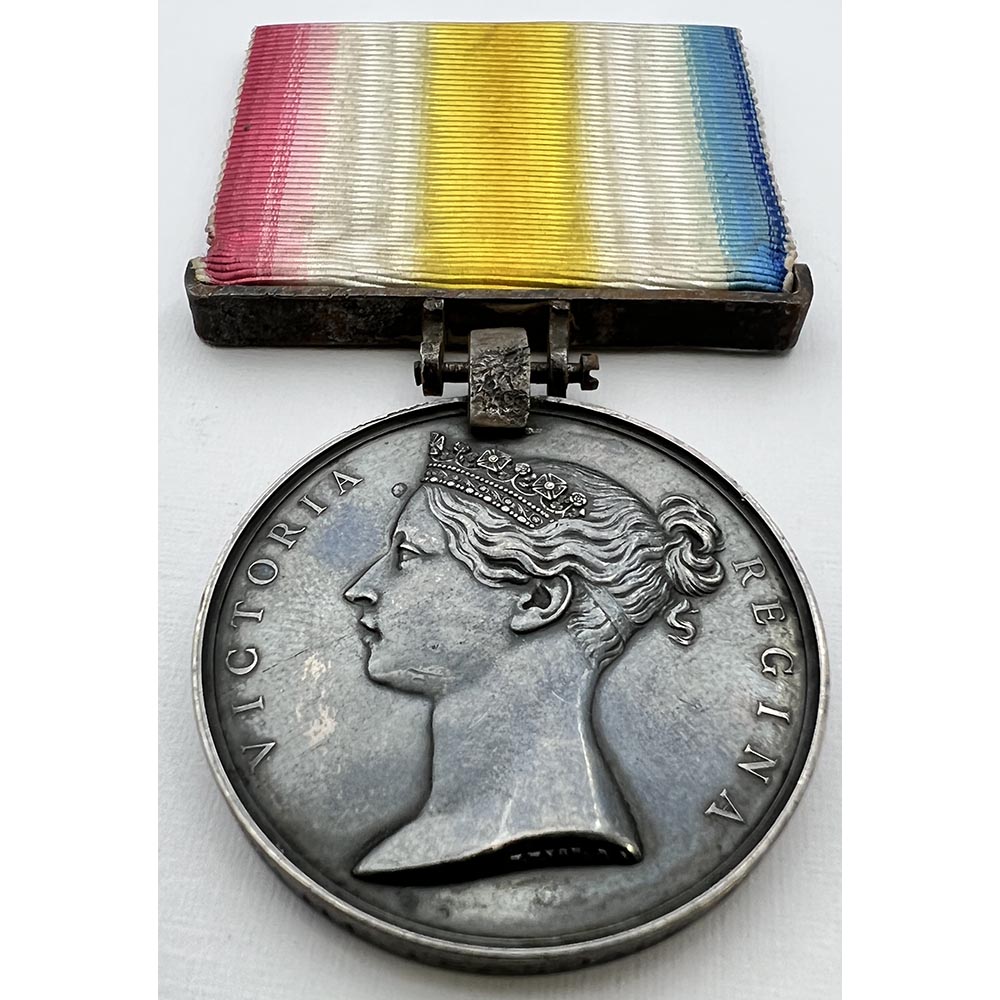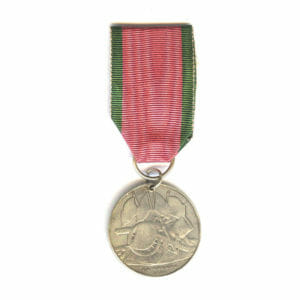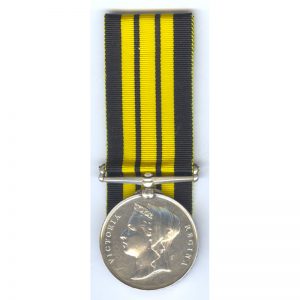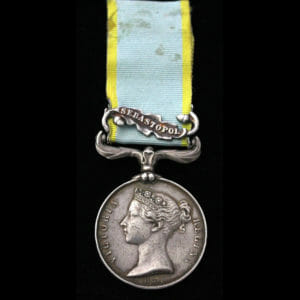Description
Scinde War Medal, for Battle of Meanee 1843 Medal, Major Henry Crawshay Teasdale, Commanding Officer, 25th Regiment of Native Infantry.
Commanding Officer of the 25th Regiment of Native Infantry, when he was, like a true commanding officer: “Major Teasdale, whilst animating his Sepoys, dashed on horseback over the bank amidst the enemy, and was instantly shot and sabred – dying like a glorious soldier!”, Sir Charles Napier recalls the Battle of Meanee, and the end of a brave Indian Army Soldier.
Major Charles Waddington, Commanding Engineer in Scinde also recalls:
“Major Teasdale, commanding the 205th, was killed while animating his Sipahees, who gave ground in an alarming manner before their fierce opponents.” He notes that command was assumed by Captain Jackson, who was the unfortunate Brother of the same Major Jackson, of the 12th who was killed in a similar fashion.
He adds that also “Lieut Col Pennefather commanding the 22nd Regt, was shot through the body, and Major Poole succeeded. Even his stout Europeans could not keep their ranks unmoved under the furious attacks of the Belochees. Defending themselves more skilfully with their bayonets than the Sipahees, they yet swerved back from the sharp sabres of their desperate foes, many of whom were excited with bhang or opium.”
Contemporarily engraved in neat upright serif capitals: “MAJOR H.C. TEASDALE 25th N.I.”
Provenance: Sold by Morton & Eden, London, Lot 712, 18th November 2020, the sale of the Griesbach Collection, hammer price £2900+24%=£3596 in total.
The auctioneers had provided that they believed the medal to have been “Officially Engraved in Upright Capitals”, but it is our opinion that the naming is contemporary but likely privately done.
The medal disc itself is close to mint condition with slight handling, with a dark storage tone, suspension consists of what looks like the original clip and straight bar suspension, both made from iron, with some slight rusting over the years.
Included is some copied research, including an extremely well detailed service file from his service papers at the British Library, which recount the entirety of his service and death.
THE BATTLE OF MEANEE or MIANI, 17th February 1843, 2,800 men under Maj Gen Charles Napier vs 30,000 under Mir Talpur.
The Bombay Gazette, 27th February 1843 reports:
“On the 16th February 1843, Major General Sir Charles Napier, KCB, marched to Mutharee, and on his arrival there, ascertained that the Ameers were in a position at Meeanee, distant about 10 miles, to the number of 22,000 men.
Being aware that any delay for reinforcements would both strengthen the confidence of the enemy and add to their numbers, although his own force was not 1/7th part of that of the enemy, Sir Charles Napier resolved upon making an immediate attack, and accordingly marched towards Meanee at 4 o’clock in the morning the 17th.
At 8 o’clock AM the advanced guard of Napier’s Force discovered the enemy camp, and at 9 o’clock the British troops formed in order of battle, being composed of about 2,800 men of all arms, 12 pieces of artillery.
The enemy opened a most determined and destructive fire upon the British troops, and during the action which ensued, with the most undaunted bravery, repeatedly rushed upon them sword in hand. After a most resolute and desperate contest, which lasted for upwards of 3 hours, the enemy was completely defeated and put to flight, with the estimated loss of about 5,000 men, 1000 of whom were left dead on the field, together with the whole of their artillery, ammunition and standards, a considerable quantity of stores and some treasure…
…The Hon. the Governor in Council deeply laments to state, that considerable loss has attended this brilliant victory.
In particular he has to deplore the following gallant officers, who, after having conspicuously distinguished themselves, nobly died on the field of battle.-
Major H.C. Teasdale, Commanding the 25th Bombay N.I. (Only Major and highest ranking casualty)
Captain W.W. Tew, H.M. 22nd Regiment
Brevet Capt and Adjutant Cookson, 9th Reg Bengal Light Cavalry.
Captain and Brevet Major W.H. Jackson, 12th Regt Bombay NI
Leut Brevet Capt R.N. Meade, 12th Regt Bombay NI
Lieut E. Wood, 12th Regt Bombay NI.” This was all 6 KIA Officers who fell in action.
On 18th February 1843, Major General Sir Charles Napier wrote his report, and sent it in to Hon Lord Ellenborough, Governor General of India.
He writes a detailed account published in the Bombay Gazette, personally recalling the gallant death of Major Teasdale which was witness:
“It is not to be supposed that so hard-fought an engagement could be sustained without considerable loss on both sides.
That of the British Force if 256 men killed and wounded. The enemy is generally supposed to have lost 5000; Major Teasdale, whilst animating his Sepoys, had dashed on horseback over the bank amidst the enemy, and was instantly shot and sabred – dying like a glorious soldier!
Major Jackson in like manner, rushed forward, 2 brave Havildars followed him, too far advanced before their men, they fell under the sabres of the enemy, but it is said not before he killed several.
Captains Meade, Tew and Cookson, with Lieut Wood, all fell honourably, urging on the assault with unmitigated valor.”
The Duke of Wellington and a young Queen Victoria, admired the Battle of Meanee.
A Massive Life Size painting was created by Edward Armitage circa 1847, of the Battle of Meanee, he had been inspired by the recent acount made by Napiers Brother William in “Conquest of the Scinde”.
When the finished painting was exhibited at Westminster Hall in 1847 it attracted great attention, Amongst the admirers, were the Duke of Wellington who “stood opposite Meanee expression aloud great admiration”, but the piece would go to the finest collection, that of Queen Victoria, purchasing it for £400 on 11st October 1847.
Charles Napier was a little annoyed however, as he preferred the imagining of Jones, who had placed him correctly up front of his men instead of in the rear. It now sits in the Royal Collection Trust.
Major Henry Crawshay Teasdale, was born on 31st October 1801, at Chancery lane in London, being the son of Richard Teasdale, a Solicitor in the Merchant Tailors Hall, and his wife Mary (Burrows).
Destined for the Military, he was educated at the Royal Military College in Sandhurst, and was nominated as a Cadet with the Bombay Establishment Honourable East India Company in 1815. He had been specially recommended by Right Honourabe John Atkins, the Lord Mayor of London.
Barely 14-15 years old, he was sent out to India joining the 1st/5th Bombay Native Infantry, with whom he was already noted as the Officiating Interpreter, having good knowledge of Hindustani.
He was commissioned as Ensign on 23rd March 1819, remarkable becoming Lieutenant the next day on 24th March 1819, joining the 25th Native Infantry, which he be would soon to Command.
Teasdale was no amateur to commanding his men in battle by the time of his gallant death at Meanee during 1843.
He was over 40 years old, with over 20 years of Army Service, and he had previously led his men to victory in the previous Afghanistan War leading up to the Scinde Campaign.
BATTLE OF KOTRA 1840
On 1st December 1840, Capt Teasdale, with Colonel Marshall led a small Force that fought and defeated Mir Mahomed Nusseer Khan and his Brahui Tribesmen at the Battle of Kotra.
Capt Teasdale, under command of Colonel Marshall, taking with him 500 Bayonets of the 25th NI, 2 Companies (180 men) of the 21st Foot under Capt Ennis, Two companies (150 men) of the 2nd Grenadiers under Capt Boys, with 90 Horsemen of the Poona Horse under Lieut Smith and 2 Gunder under Lieut Pruen.
They had only a force of about 1,000 men, Teasdale led them into action and was victorious.
The British had found Nusseer Khan’s Camp at Dhadar in Baluchistan, who was just a child of 14 years old, but surrounded by a number of competing advisors.
Colonel Marshall took about half the men, 350 infantry and 50 Horses to attack the camp from one direction, whilst Capt Teasdale, with his 500 Bayonets, did a simultaneous attack from the opposite side.
The British took only 5 killed and 30 wounded, about 500 of the Brahui Tribesmen were killed, and young Mir Nusseer Khan escaped.
BATTLE OF HYKULZYE, 28th-29th APRIL 1842
Another battle, with Capt Teasdale in command of his corps, was the disastrous Affair at the village of Hykulzie.
The Battle was a masterful victory over the British, in short, the combined Force under Maj Gen England had attacked a force of what they thought was roving tribesmen near the village of Hykulzye, forcing them into a retreat. By the time they mounted an attack on his force, which was deemed to be weak, they were in for a big surprise. The enemy had been lying in wait for months, making careful preparation to repulse the British, when the Light Company of the 41st reached the heights, a superior force that had lay concealed, sprung up and repulsed them with rocks and careful aim with matchlocks.
This was not the end of their trouble, for as soon as they began to attempt to retire, a considerable cavalry force rode in behind them, and rode straight through the British, as they attacked, the riflemen at the top of the heights continued to rain down on their backs.
During the battle, The 3 Columns of attack were led by Major Simmons, 41st Foot, Captain Woodburn 25th Regiment NI and Major Corchran, 41st Regt, the latter being accompanied by a wing of 25th Bombay N.I. under Captain Teasdale commanding that corps.
The British Force would rather forget this battle and sometimes gloss over it, they were however forced to admire the ferocity of the enemy, it was noted that the enemy force had:
“Fought with all the fury of religious zealots, determined to conquer or to perish. The Officers admit that a better sustained fire they have rarely seen: and that the Cavalry as Irregulars could hardly be surpassed. The whole affair was one of 3 minutes. Having found that our squares were not to be broken, the Affghans rapidly retired, but in perfect order.”
This retirement happened to be a delicate bait, when the Light Company pressed the “retiring” enemy, they ran up the heights and were met by a trench of thorns, which had actually been the preparation of 2 months, they then received a rain of bullets and rocks upon them.
With their rear exposed, the enemy forced had “Kept his strength concealed behind a succession of breast works improve dby a ditch and abbatis, until our advance reached the crest of his exterior defence, when a crowded body suddenly sprung up, and made the contest so unequal that it was immediately evident it could not be advantageously maintained.
The light companies fell back, therefore, on the small supporting column of the Majesty’s 41st Regiment, which, on the appearance of the enemy’s cavalry, which now rushed out from behind the hills, had formed square, and gallantly resisted the efforts which were made to break it, the matchlocks keeping up a sharp and destructive fire from the heights.”
The unlucky love life, of Major Teasdale, involving 3 marriages, the second of whom was an Indian Princess.
His 1st wife had died, when he was then betrothed to Princess Budhson (or Bakshan) (1803-1831), who was one of the Daughter Princesses of the late Raja Shahu II Bhonsle, Emperor of the Maratha Empire, Chhatrapatai of the Maratha Empire, was Shahu II of Satara.
He had 2 children with the Princess, in 1824, Ellen Teasdale, and also a son, Henry Jackson Teasdale, during 1830.
This marriage conveniently occurred possibly as some sort of peace offering, just after the end of the Third Anglo-Maratha War of 1817-1819, which left the HEIC in control of almost all of India south of the Sutlej River, which ended with the British installing Raghuji Bhonsle III, a 10 year old child, as the new Maratha Ruler.
Her father had won the 1st Anglo-Maratha War against the British HEIC and lost the Second Anglo-Maratha War during before his death in 1808.
The Princess died in 1831, and he found himself marrying one final time to his now 3rd Wife, Jessie Eliza Anabella Whitehill on the 1st June 1839.
Having lost 2 previous wives, he would then make her a Widow, when he was killed in action, she would have been the one to receive his medal after his death most likely.
Not taking long to grieve, she would remarry, to Captain Robert St John, of the 1st Bombay European Fusiliers during 1845
